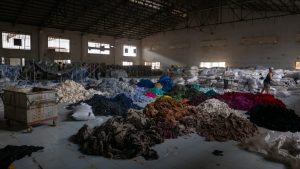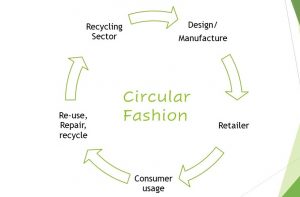

The fashion industry has been changing quite a bit over the last few years and there have been many developments in the industry. The two major developments are sustainability and digitization, they will be unavoidable in the coming years. Sustainability and digitization define how fashion, production and consumer behaviour will evolve in the future. The other developments (also important but not major) are circularity and regenerative fashion. But what exactly is sustainability, digitization, circularity and regenerative fashion? Well, let’s break it down.

Sustainability
The dictionary defines sustainability as ‘the quality of not being harmful to the environment or depleting natural resources and thereby supporting long-term ecological balance’. In other words, it means not using more natural resources than the planet can naturally replace and not producing anything that the planet can’t naturally reabsorb. The fashion industry follows the ‘take, make, dispose’ cycle and that is detrimental to the environment, the 4 main issues caused by this are:
- Water consumption and contamination– Water pollution occurs when harmful substances such as chemicals or microorganisms contaminate any body of water degrading water quality causing it to be toxic to humans or the environment.
- Energy emissions– The fashion industry is generating a lot of greenhouse gases due to the energy used during the production, manufacturing, and transportation stages.
- Chemical usage– The heavy use of chemicals in cotton farming such as fertilizers and pesticides are causing diseases and premature death among cotton farmers. It also causes massive freshwater and ocean water pollution and soil degradation.
- Waste creation– The levels of clothing that are incinerated or sent to landfills are enormous and many are made of synthetic fibres like polyester. These fabrics are plastic fibres, therefore non-biodegradable.
Digitization
Digitization is the process of converting information into a digital format, in this case, digital clothing. You’re probably thinking, what? digital clothing? Let’s go into more detail. Digital imagery is revolutionizing the way fashion products are designed, presented and sold. Many fashion brands are now looking to digitize the supply chain and create digital clothing before creating physical ones. The digital transformation of fashion design and the supply chain is good as it means cost savings, sustainability gains including removing textile waste and reducing the need for dyeing, water use and the carbon emissions generated by physical sampling. It also means there is the ability to manufacture small quantities of products profitably as you are able to market real-looking, 3D-developed products online before they have been produced and it allows fashion to react much faster to trends. On the other hand, there are problems with digitization such as the threat of job security and the loss of the human touch in fashion design, garment-making and the shopping experience.

Circularity
This brings us to the 3rd out of the four most important developments in the fashion industry: Circularity, the fashion consumption without resource consumption. Anna Brismar who is the founder and owner of Green Strategy developed the idea of circular fashion based on the circular economy. It is the concept drawing on principles such as designing out waste and ensuring clothing can be remade again and again. There are already a number of brands that are addressing the issue and putting circularity into practice but the number of recyclable products is still negligible.
Regenerative Fashion
The 4th development in the industry is the reduction of the CO2 Footprint. Regenerative fashion refers to clothing made in ways that support circularity. This type of fashion integrates fibres that are produced through Regenerative farming; a type of agriculture that follows the guidance of Indigenous Ecological Knowledge. Regenerative farming is the most effective way to reverse climate change and encourage food security by rebuilding organic carbon, restoring soil, increasing biodiversity, and reducing atmospheric carbon. Since clothing is one of the causes of the high CO2 footprint, it only makes sense for the fashion industry to start here.

Summary
The fashion industry is the second-largest polluter in the world. Freshwater and ocean pollution, the accumulation of textile waste, and the emission of greenhouse gases (as mentioned above) are just a few examples of the disastrous environmental impacts of the industry. The four main developments in the fashion industry sustainability, digitization, circularity and regenerative are the focus of the fashion industry right now for a better future in fashion. If you want to have more insight on the fashion industry click here for a blog about the Fashion Retail Industry.








